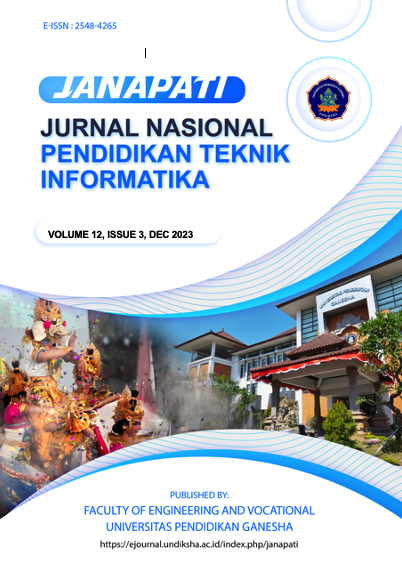Usability Testing on The Mobile Gras (Green Trash System) Application Using The Usability Scale System Method
DOI:
https://doi.org/10.23887/janapati.v12i3.68930Keywords:
System Usabilty Scale, Mobile Application Development, User SatisfactionAbstract
This study focuses on the GRAS (Green Trash System) mobile application, developed under the KEDAIREKA program to enhance waste management efficiency. The application is an integral part of the GRAS smart waste system, designed to facilitate real-time monitoring and reporting of waste capacity issues. The primary objective is to streamline waste sorting processes and educate users, particularly students, about sustainable waste management practices. The system features innovative sensor technology that provides audio feedback for correctly sorted waste, thus reinforcing correct behaviors. To assess the application's effectiveness, we conducted a usability test using the System Usability Scale (SUS) method. Data were collected through questionnaires to evaluate the application's ease of use, efficiency, and user satisfaction. The results indicated a high level of usability, with most users experiencing seamless interaction with the application, affirming its potential as a tool for effective waste management education and practice.
References
Ditjen Cipta Karya Departemen Pekerjaan Umum, Modul Pelatihan Manajemen Persampahan. 1993.
I. G. M. N. Desnanjaya and I. M. A. Nugraha, “Portable waste capacity detection system based on microcontroller and website,” in Journal of Physics: Conference Series, 2021. doi: 10.1088/1742-6596/1810/1/012001.
A. Kumar, “Cross Platform Development using Flutter,” International Journal of Engineering Science and Computing, vol. 9, no. 4, 2019.
H. A. M. Malik, A. Muhammad, and U. Sajid, “Analyzing Usability of Mobile Banking Applications in Pakistan,” Sukkur IBA Journal of Computing and Mathematical Sciences, vol. 5, no. 2, 2021, doi: 10.30537/sjcms.v5i2.883.
N. Z. A. Fakri, A. Ismail, and A. M. Lokman, “User Requirements and Usability Testing on a Mobile Application for Food Ordering Canteens,” Malaysian Journal of Medicine and Health Sciences, vol. 18, 2022, doi: 10.47836/mjmhs18.s9.5.
I. Maramba, A. Chatterjee, and C. Newman, “Methods of usability testing in the development of eHealth applications: A scoping review,” International Journal of Medical Informatics, vol. 126. 2019. doi: 10.1016/j.ijmedinf.2019.03.018.
M. Kuhnel, L. Seiler, A. Honal, and D. Ifenthaler, “Mobile learning analytics in higher education: usability testing and evaluation of an app prototype,” Interactive Technology and Smart Education, vol. 15, no. 4, 2018, doi: 10.1108/ITSE-04-2018-0024.
J. Y. Lee et al., “Development and usability of a life-logging behavior monitoring application for obese patients,” J Obes Metab Syndr, vol. 28, no. 3, 2019, doi: 10.7570/JOMES.2019.28.3.194.
“SUS: A ‘Quick and Dirty’ Usability Scale,” in Usability Evaluation In Industry, 2020. doi: 10.1201/9781498710411-35.
N. Huda, “IMPLEMENTASI METODE USABILITY TESTING DENGAN SYSTEM USABILITY SCALE DALAM PENILAIAN WEBSITE RS SILOAM PALEMBANG,” Kumpulan jurnaL Ilmu Komputer (KLIK), vol. 6, no. 1, 2019, [Online]. Available: www.siloamhospitals.com
K. T. Nugroho, B. Julianto, and D. F. Nur MS, “Usability Testing pada Sistem Informasi Manajemen AKN Pacitan Menggunakan Metode System Usability Scale,” Jurnal Nasional Pendidikan Teknik Informatika (JANAPATI), vol. 11, no. 1, p. 74, Apr. 2022, doi: 10.23887/janapati.v11i1.43209.
J. R. Lewis, “The System Usability Scale: Past, Present, and Future,” Int J Hum Comput Interact, vol. 34, no. 7, 2018, doi: 10.1080/10447318.2018.1455307.
G. W. Sasmito, L. O. M. Zulfiqar, and M. Nishom, “Usability Testing based on System Usability Scale and Net Promoter Score,” in 2019 2nd International Seminar on Research of Information Technology and Intelligent Systems, ISRITI 2019, 2019. doi: 10.1109/ISRITI48646.2019.9034666.
R. S. Pradini, R. Kriswibowo, and F. Ramdani, “Usability Evaluation on the SIPR Website Uses the System Usability Scale and Net Promoter Score,” in Proceedings of 2019 4th International Conference on Sustainable Information Engineering and Technology, SIET 2019, 2019. doi: 10.1109/SIET48054.2019.8986098.
A. C. Wijaya, M. Wiranto Aris Munandar, and F. Utaminingrum, “Usability Testing of Augmented Reality for Food Advertisement Based on Mobile Phone Using System Usability Scale,” in Proceedings of 2019 4th International Conference on Sustainable Information Engineering and Technology, SIET 2019, 2019. doi: 10.1109/SIET48054.2019.8986118.
A. Belkhir, M. Abdellatif, R. Tighilt, N. Moha, Y. G. Gueheneuc, and E. Beaudry, “An observational study on the state of REST API uses in android mobile applications,” in Proceedings - 2019 IEEE/ACM 6th International Conference on Mobile Software Engineering and Systems, MOBILESoft 2019, 2019. doi: 10.1109/MOBILESoft.2019.00020.
F. F. Reichheld, “The One Number You Need to Grow,” Harvard Business Review, vol. 81, no. 12. 2003.
Downloads
Published
How to Cite
Issue
Section
License
Copyright (c) 2024 I Gusti Made Ngurah Desnanjaya, I Kadek Budi Sandika, Ida Bagus Gede Sarasvananda, Putu Wirayudi Aditama, I Komang Arya Ganda Wiguna

This work is licensed under a Creative Commons Attribution-ShareAlike 4.0 International License.
Authors who publish with Janapati agree to the following terms:- Authors retain copyright and grant the journal the right of first publication with the work simultaneously licensed under a Creative Commons Attribution License (CC BY-SA 4.0) that allows others to share the work with an acknowledgment of the work's authorship and initial publication in this journal
- Authors are able to enter into separate, additional contractual arrangements for the non-exclusive distribution of the journal's published version of the work (e.g., post it to an institutional repository or publish it in a book), with an acknowledgment of its initial publication in this journal.
- Authors are permitted and encouraged to post their work online (e.g., in institutional repositories or on their website) prior to and during the submission process, as it can lead to productive exchanges, as well as earlier and greater citation of published work. (See The Effect of Open Access)







